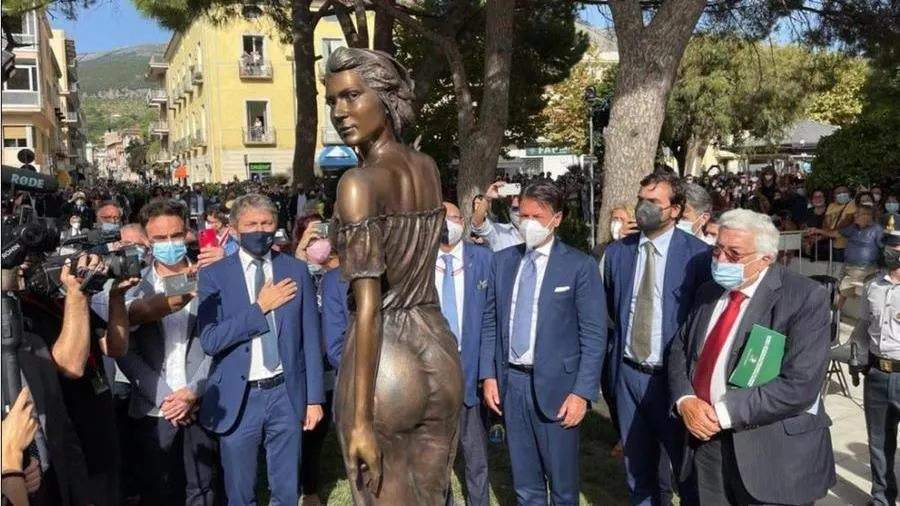Controversy erupts over a bronze sculpture unveiled Sunday, Sept. 26, in Sapri (Salerno, Italy), dedicated to the figure of the gleaner, the protagonist of the famous poem La spigolatrice di Sapri by Luigi Mercantini (Ripatransone, 1821 - Palermo, 1872) dedicated to Carlo Pisacane ’s 1857 expedition: in the lyric the landing at Sapri is told from the point of view of the field worker who witnesses the unfortunate feat of the anti-Bourbon troops and the ensuing massacre (“Eran trecento, eran giovani e forti, / e sono morti”). In fact, the sculpture, the work of young Cilento artist Emanuele Stifano, shows a comely young woman, clad in a tight-fitting robe that seems almost wet and gives a glimpse of her forms without leaving too much room for the imagination (her buttocks in particular), and she is posed in a pose that many have interpreted as lascivious and winking.
Launching the controversy was, on Sunday around lunchtime, former senator of the mixed group, with a past in Forza Italia, Manuela Repetti, who spoke of a “sexist slap in the face” dealt by this statue, suggesting that it be “taken down.” “In 2021,” Repetti wrote, “we are still like this, inaugurating things like this that are a sexist slap in the face to all women, especially those who every day try to fight that devious machismo that crawls in every corner of daily life, especially in our country that boasts records of mistreatment and feminicides, also the result of a vision of women still as objects to be possessed.” Moreover, curiously enough, photos of the unveiling show in front of the statue an audience of only men (among them was former Prime Minister Giuseppe Conte, who these days is touring Italy to campaign for the upcoming local government elections), a circumstance that exacerbated the macho atmosphere of the situation. Strong criticism also came from Pd deputy Laura Boldrini (“It is an offense against women and the history they should celebrate. But how can even institutions accept the representation of women as sexualized bodies? Male chauvinism is one of the evils of Italy”) and by her colleague Monica Cirinnà, who like Repetti speaks of “a slap in the face to history and to women who are still only sexualized bodies,” and notes how the figure of Stifano has nothing that refers to the figure of the field worker who “chose not to go to work to stand against the Bourbon oppressor.”
Squaring off around the statue are ... males, starting with Pentastellist Senator Francesco Castiello, who directly addresses Repetti: “What seems to have caused serious disturbance to the aforementioned was her light clothing and pronounced form. It escapes the former senator, who belongs to a territorial area many hundreds of kilometers above the parallel of Sapri, what the physical features of southern women are.” Castiello adds that “the landing took place in late June in a scorching southern Italian summer, when those in the hard work of wheat harvesting certainly could not wear a pastern with padding.” The operation was also defended by the mayor of Sapri, Antonio Gentile, who does not understand the controversy: “It is a very beautiful statue, well placed,” he said, “representing an instant of Luigi Mercantini’s poetry, with the gleaner turning her gaze toward the place of the landing and the wind moving her clothes. It was not a nude. Today in 2021 we cannot continue to pass the message that sexism is the object we are looking at and not in the eyes of the sexist. It is the look of the person who sees the thing the hymn to sex, certainly not the object that causes sexism.”
The author also intervened in the controversy and declared himself astonished: “If it were up to me,” Emanuele Stifano wrote on his Facebook profile, “I would have made a completely nude figure, the same goes for the Palinuro of a few years ago and for the statues I will make in the future, simply because I am a lover of the human body in general and I like to work with it. However, I think it’s useless to give explanations to people who absolutely want to see depravity or various things in it. When I make a sculpture I always tend to cover the human body as little as possible, regardless of gender. In the case of the Gleaner, since she was to be placed on the seafront, I took advantage of the sea breeze blowing over her to give movement to the long skirt, and thus highlight the body. This was to emphasize an anatomy that was not meant to be a faithful snapshot of a nineteenth-century peasant woman, but to represent an ideal of a woman, to evoke her pride, the awakening of a consciousness, all in a moment of great pathos. I should add that the preparatory sketch was viewed and approved by the commissioning party. To those who do not know me personally, I say that I am constantly questioning my work, working humbly and always trying to improve myself, far be it from me to approach the great masters of the past who represent a beacon that guides and inspires me.”
In short, it is a discussion that touches on several issues: ideal models for public statuary, censorship and artists’ freedom of expression, and the objectification of the female body. Topics that are far from easy and would perhaps require long and calm discussions rather than ephemeral flare-ups on social media.
 |
| There is controversy over the sculpture of the sexy gleaner in Sapri. Sexist |
Warning: the translation into English of the original Italian article was created using automatic tools. We undertake to review all articles, but we do not guarantee the total absence of inaccuracies in the translation due to the program. You can find the original by clicking on the ITA button. If you find any mistake,please contact us.